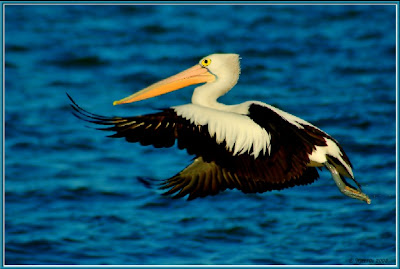You cannot help noticing them, their beauty and sheer size and gracefulness on water and in the air is very impressive, however, on land they are quite comical to watch as they sway from side to side careful not to trip over their very large webbed feet.
Pelecanus conspicillatus - the Australian Pelican.
As though the pelican was waving goodbye, leaving for it's breeding grounds thousands of kilometers inland, it was possible for me to get this photograph.
In Australia they are found living widespread on freshwater, estuarine and marine wetlands and waterways including lakes, swamps, rivers, coastal islands and shores, well anywhere that water can be found.
Pelicans mainly eat fish, however, they are also opportunistic feeders and eat a variety of aquatic animals including crustaceans, tadpoles and turtles. They readily accept 'handouts' from humans, and strange items has been recorded in their diet. During periods of starvation, pelicans have been reported capturing and eating seagulls and ducklings. They hold the gulls under water and drown them before eating them headfirst. Pelicans also robs other birds of their prey. I guess it is a case of 'I am larger than you therefore I can bully you or eat you'.
Pelicans weigh 4.0 - 6.8 kg, are 1.6 - 1.8 m long. They also have large wings and a wingspan of 2.3 - 2.5 m. They have an extremely light skeleton, weighing less than 10% of their total body weight.
Pelicans are not capable of sustained flapping flight, but can remain in the air for 24 hours, covering hundreds of kilometres. They are excellent soarers and can use thermals to rise to considerable altitudes. Flight at 1,000m is common, and heights of 3,000m have been recorded. By moving from one thermal to the next, pelicans can travel long distances with a minimum of effort, reaching air speeds of up to 56 km/hour.
The wild pelican's lifespan is approximately 25 years.
When it's very hot pelicans flutter their throat pouches to keep cool.
Normally they are also silent birds, except for the occasional grunt.
I never tire from watching them. They are incredible birds.















